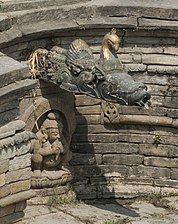Bhagiratha
| Bhagiratha | |
|---|---|
Grandson of Sagara | |
 Descent of Ganga to Earth | |
| Affiliation | devotee of Ganga |
| Genealogy | |
| Parents |
|
Bhagiratha (Sanskrit: भगीरथ, Bhagīratha) is a legendary king of the Ikshvaku dynasty who brings the River Ganges, personified as the river goddess Ganga, to Earth from the heavens.
Story
It is said that after Bhagiratha became prince of Sagara Dynasty, learning the awful end of his forefathers, who were unable to attain region of gods, he regretfully made over his kingly duties to his minister and went to practice austerities in the Himalayas. On the advice of his guru Trithala, he did penance for a thousand years (according to god timeline) to please Ganga, to gain the release his 60,000 great-uncles from the curse of saint Kapila. Ganga told Bhagiratha that if she were to descend from the sky to the earth, the force of her fall would be difficult to sustain. She asked him to obtain the favour from the black-haired, blue-throated god Shiva, as no one except him would be able to sustain her. Bhagirtha then did severe penance for Shiva and asked him to do so. Shiva granted him the boon, which eventually led to descent of the goddess Ganga to the earth in the form of the river Ganges, filling the sea, drunk up by Jahnu.[1][2] To commemorate his efforts, the head stream of the river is called Bhagirathi, till it meets Alaknanda River at Devprayag.
Birth
In most accounts of Bhagiratha, he is born to his father Dilipa and his unnamed mother in an unremarkable fashion. However, a number of Bengali accounts tell how Dilipa dies without begetting an heir, leading to a rare example of a myth about female same-sex reproduction. This story may first be attested in the Bengali-script recension of the Sanskrit Padma Purana; it recurs in the influential, probably fifteenth-century CE Bengali Krittivasi Ramayan, and thereafter in other texts from Bengal such as Bhavananda's Harivansha, Mukundarama Chakravartin's Kavikankanachandi, and the sixteenth-century Ramayana by Adbhutacharya.
Dilipa's lack of an heir troubles the gods, because it has been prophesied that Vishnu will be born to Dilipa's line, and this prophecy cannot come true unless Dilipa has a child. Therefore, through the advice of a sage or god, two of Dilipa's widows have sex with one another and in this way one gets pregnant and gives birth to Bhagiratha. However, the baby is deformed (in the Padma Purana version, for example he is boneless, while in the Krittivasi Ramayan he is merely a lump of flesh) until he encounters the crippled sage Ashtavakra, who transforms him into a beautiful, strong child/youth. The Krittivasi Ramayan even goes on to describe Bhagiratha being bullied at school for having two mothers rather than heterosexual parents. Some of the texts too use the story to provide a folk-etymology for Bhagritha's name, claiming that it comes from bhaga ('vulva').[3][4][5][6]: 146–60 [7]
Representation in sculpture
A sculpture of Bhagiratha can be seen beneath the spout of almost every dhunge dhara (hiti) or tutedhara (jarun, jahru, jaladroni), two types of drinking fountain found in the old settlements of Nepal. Bhagiratha is pictured dancing or sitting while holding or blowing a conch. A similar figure can be seen below the gargoyles in some temples in India.[8]
Gallery
-
Bhagiratha beneath the main spout of Sundhara, Kathmandu, Nepal
-
Bhagiratha on a jarun of Nag Pokhari, Bhaktapur, Nepal
-
Bhagiratha beneath the stone spout of Lamugah Hiti, Bhaktapur, Nepal
-
Bhagiratha on a jarun at Taumadhi Square, Bhaktapur, Nepal
-
Bhagiratha beneath a gargoyle at the Brihadisvara Temple, Thanjavur, India
-
Shiva Gangadhara, Parvati, Bhagiratha (left) at the Ravana Phadi Cave, Aihole, India
-
Bhageeratha statue in Hyderabad, India
See also
References
- ^ Mankodi, Kirit (1973) "Gaṅgā Tripathagā"Artibus Asiae 35(1/2): pp. 139-144, p. 140
- ^ "The Mahabharata, Book 3: Vana Parva: Tirtha-yatra Parva: Section CVIII". www.sacred-texts.com. Retrieved 2019-04-14.
- ^ Ruth Vanita, '"Wedding of Two Souls": Same-Sex Marriage and Hindu Traditions', Journal of Feminist Studies in Religion, 20.2 (Fall, 2004), 119-35.
- ^ Ruth Vanita, 'Disability as Opportunity: Sage Ashtavakra Mentors Bhagiratha, the Disabled Child of Two Mothers', in Gandhi's Tiger and Sita's Smile: Essays on Gender, Sexuality and Culture (New Delhi: Yoda, 2005), pp. 236-50; ISBN 81-902272-5-4.
- ^ Ruth Vanita, 'Born of Two Vaginas: Love and Reproduction between Co-Wives in Some Medieval Indian Texts', GLQ: A Journal of Lesbian and Gay Studies, 11 (2005), 547–77, doi:10.1215/10642684-11-4-547.
- ^ Ruth Vanita, Love's Rite: Same-Sex Marriage in India and the West (New York: Palgrave Macmillan, 2005).
- ^ Ruth Vanita, 'Naming Love: The God Kama, the Goddess Ganga, and the Child of Two Women', in The Lesbian Premodern, ed. by Noreen Giffney, Michelle M. Sauer, and Diane Watt (New York: Palgrave Macmillan, 2011), 119-30; ISBN 978-1-349-38018-3 doi:10.1057/9780230117198.
- ^ Water Conduits in the Kathmandu Valley (2 vols.) by Raimund O.A. Becker-Ritterspach, ISBN 9788121506908, Published by Munshiram Manoharlal Publishers Pvt. Ltd., New Delhi, India, 1995
Sources
- The Ramayana (2001) by Ramesh Menon
- http://moralstories.wordpress.com/2006/05/14/hard-work-can-do-wonders/
- Dictionary of Hindu Lore and Legend (ISBN 0-500-51088-1) by Anna L. Dallapiccola
- The story of Baghiratha in western edition[permanent dead link]








